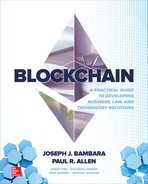8 Private Blockchain Platforms and Use Cases
Blockchain is a peer-to-peer distributed ledger technology, which makes it easier to create a more cost-efficient network with no central point of control. This is in contrast to the world where members of a business ecosystem maintain their own ledger or systems of record (SOR). These separate ledgers are continually being reconciled with one another in an inefficient, expensive, and often nonstandard way. Over time, these separate ledgers have been duplicated many times within each member’s datacenters. It has gotten to the point where data governance, testing, release management, and in effect the complete software development life cycle (SDLC) is always hampered and more or less broken or damaged. It is no wonder that these institutions cannot innovate fast enough. It’s like trying to run a race while dragging a trailer containing all the clothing you’ve ever owned throughout your lifetime!
However, recently the concept of private blockchains has become popular within the discussions on blockchain technology, particularly among financial institutions. Instead of having a fully decentralized network open to the public with anonymous parties, it is possible to create a system where each party is identified and granted permissions to change or read the blockchain. These private blockchains are also tackling the performance issue because consensus is performed on fewer nodes. In fact, it is likely that there will be many blockchain networks with each network serving a different set of goals and distinct business applications (see Figure 8-1).
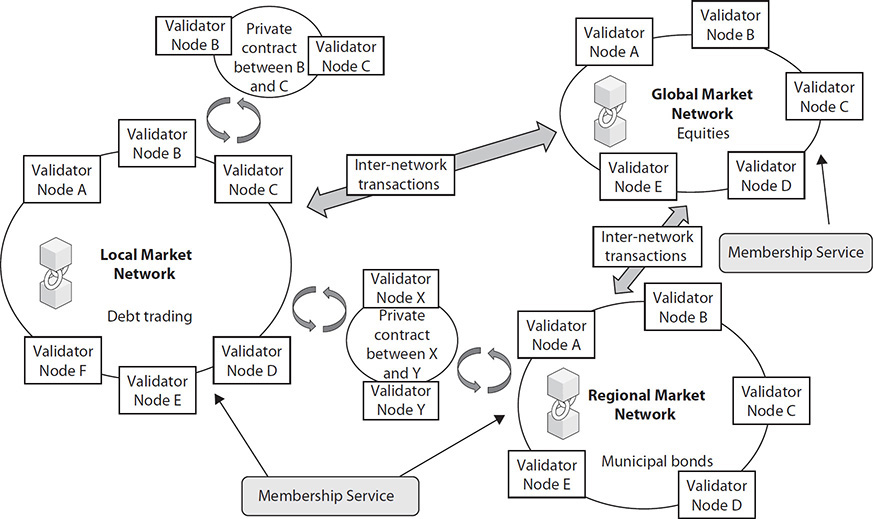
FIGURE 8-1 Many blockchain networks
It is important to note that there is some discussion that these private blockchains are compromising the central concept of decentralization. But for the purposes of this book let’s take a look at the differences between the types or categories of blockchain.
Categories of Blockchain
Generally speaking, there are three categories of blockchain-like database applications: public, consortium, and private.
• Public Anyone can read or submit transactions (submissions will be committed if valid), and anyone can participate in the consensus process. These trustless platforms are secured by mechanisms such as proof of work or proof of stake, a.k.a. cryptoeconomics. In other words, influence in the consensus process is proportional to the quantity of economic resources that entity can bring to bear.
• Consortium Consensus is controlled by a preselected set of nodes and rules for achieving consensus. The right to read the blockchain can be open to the public, or it can also be restricted to a set of known participants—for example, 10 banks in a consortium that agree to the consensus rule that 7 of 10 banks must sign (approve) a block for it to be considered a valid representation of the truth.
• Private Write permissions are kept centralized to a single organization or part of it. Read permissions may be public or restricted to a set of known participants.
In short, there are really two categories, public and private. The consortium is a derivative of the private blockchain with multiple identified and permissioned members/participants.
Here is a list of the advantages of a private blockchain:
• When read permission is enforced, a private blockchain provides privacy.
• A consortium or private entity can change the rules of a blockchain, allowing them to revert transactions, modify (fix) balances, etc. This functionality may be deemed necessary, although we must say these reasons look more like patches to fix defective functionality.
• The miners (or validators) are identified, defined, and known, so any risk of a 51 percent attack from colluding bad actors does not exist or can easily be identified and dealt with.
• Transactions are less expensive, since they only need to be verified by a limited set of trusted (and identified) nodes instead of by every node on the public network. There does not have to be any transaction fee. There may still be a requirement to run a validator node to participate in the network. This would be an expense, but would be less expensive to participants than a transaction fee on the public network. The validator node may also provide protection against a distributed denial-of-service (DDoS) attack.
• With fewer miners needed, consensus finality can be achieved much faster among a smaller group.
So, given the above, it is no surprise that financial institutions invariably choose private (or consortium) platforms for their blockchain applications. It is also a reason that private blockchains are also known as enterprise blockchains.
Private Blockchain Use Cases
The public blockchain has, in many cases by design, the following challenges to enterprise adoption, particularly those industries that are highly regulated:
• No privacy
• Anonymous processors
• Little to no governance
• Limited throughput with slow transaction confirmation (performance challenge)
In short, there are essentially two aspects to privacy itself: read permission and block generation (or write) permission. If the use case requires privacy, you will want to restrict read permission. If the use case requires trust spread across a limited and predetermined set of participants, you will want to restrict write permission. Both aspects individually or collectively may push you to a private (or consortium) blockchain platform.
Throughout this chapter we mention use cases for private blockchains. The following is a more complete collection of use cases:
• A permissioned interfinancial institution settlement layer for digital assets (currencies and securities)
• An intracompany ledger (balance sheet) containing private data without any single department being in authoritative control
• A permissioned platform for the issuance and maintenance of rewards, loyalty points, and gift cards
• A tracking tool for private equity, debt, and other liquid agreements
• Database management, auditing, etc., internal to a single company
• Any use case that requires incredibly high numbers of transactions per second
Again, the considerations for choosing a private blockchain platform can be narrowed down to the requirements depicted in Figure 8-2.

FIGURE 8-2 Requirements leading to private blockchains
Private Blockchain Technology
This section presents blockchain technology platforms that are applicable for the private and consortium spaces.
AlphaPoint Distributed Ledger Platform

Website: https://www.alphapoint.com/adlp.html
AlphaPoint Distributed Ledger Platform is a private, permissioned protocol that leverages blockchain, and it further allows firms complete control over their data. ADLP’s key benefits are:
• Secure architecture Multiple entities communicate and link via encrypted messages across secure networks.
• Permissioned Parties can only access data that is explicitly shared with them.
The platform enables organizations to digitize, manage, and exchange financial instruments; deploy smart contracts along with automated workflows; and therefore reduce operational overhead.
Chain Core

Website: https://chain.com
Chain Core is a permissioned blockchain platform that is used to issue and/or transfer financial assets. Using it, financial institutions can launch and operate a blockchain network or connect to other networks in order to move assets around. The Chain protocol handles this by defining how assets are issued, transferred, and controlled. It allows a single entity (private) or a group of organizations (consortium) to operate a network, supports the coexistence of multiple types of assets (e.g., currencies, securities, derivatives, gift cards, and loyalty points), and has a degree of interoperability with other independent networks.
Corda

Website: https://www.corda.net
Corda is an open-source platform that implements a distributed ledger made up of mutually distrusting nodes that records the state of deals and obligations between entities, which can be institutions or individuals. Unlike Ethereum, Corda’s smart contracts are currently limited to the application of financial logic, and all nonfinancial applications are out of scope.
One of Corda’s key features is pluggable consensus within the same network. This feature supports multiple consensus providers, and each can employ different algorithms. This type of distributed ledger has many applications focused around commerce, such as finance, trade, and supply chain tracking. Other key features are that this is a permissioned network, with access controlled by a doorman (TLS certificate provided to each node participant upon successful registration), and that all communication between nodes is point-to-point, instead of being sent to all nodes in a global broadcast.
Domus Tower
![]()
Website: http://domustower.com
Domus Tower has a vertical blockchain product that is solely designed to settle U.S. equities. The company’s key selling point is that its technology can record a high rate of transactions in a scalable manner. The company’s whitepaper begins with a statement that the product has been “benchmarked at ingesting over 1 million transactions per second on hardware costing less than $50 per hour on Amazon’s Web Services with the potential to scale to greater than 10 million transactions per second.”
It uses a double-entry approach for credits and debits, and data storage is contained in a Merkle directional acyclic graph (MerkleDAG), which ensures that the blockchain has not been altered or corrupted. All data transmitted to the blockchain is digitally signed and verified before it is written to a block. Authority is centralized under this model, and any node on the network that has write permission to a blockchain can write transactions to that chain.
The Elements Project

Website: https://elementsproject.org
Elements Core is an open-source, protocol-level technology developers can use to extend the functionality of Bitcoin to build new applications. Combinations of Elements (functionality) developed in this technical community can be brought together and fashioned into sidechains. It uses the periodic table and associated chemistry approaches to the naming and combining of functionality to build an application.
The current list of Elements are:
• Ai (Asset Issuance) Ability to issue confidential assets that represent any asset such as vouchers, coupons, currencies, deposits, bonds, shares, etc.
• Ct (Confidential Transactions) In a cryptographic way this keeps the amounts transferred visible only to participants in the transaction and those they designate, while still guaranteeing that no more coins can be spent than are available (double-spend).
• Dp (Deterministic Pegs) Allow cross-chain transactions to be constructed in a decentralized fashion, where tokens can be moved from one blockchain to another.
• Op (New Opcodes) Delivers new and re-enables some safe but disabled operation codes in Bitcoin (i.e., string concatenation, substrings, integer shifts, and some bitwise operations).
• Rtl (Relative Time Lock) Allows a transaction to be time-locked, preventing its use in a new transaction until a relative time change is achieved.
• Sb (Signed Blocks) Allows the creator of the block to verify their identity in the future.
• Scv (Signature Covers Value) Signature on a transaction can be invalidated if the inputs have been spent. Transaction can be validated fast by checking its signature.
• Ss (Schnorr Signatures) New way of constructing signatures for transactions.
• Sw (Segregated Witness) Reduces the required space for transactions in a block by a factor of 4.
Additionally, there are proposed Elements under development that are not yet ready for deployment on a public sidechain.
HydraChain

Website: https://github.com/HydraChain/hydrachain
HydraChain is 100 percent compatible with Ethereum; it extends the platform by adding support for creating permissioned distributed ledgers for private or consortium chain applications. All existing tools on the Ethereum platform can be reused. The essential difference is that HydraChain does not use proof-of-work for consensus, it relies on a registered and accountable set of validators, which propose and validate the order of transactions.
Hyperledger
Hyperledger is the umbrella project of open-source blockchains and supporting tools that was started in December 2015 by the Linux Foundation. The purpose of Hyperledger is to advance blockchain technology by identifying and then addressing important features that can transform the way business transactions are conducted on a distributed ledger.

The requirements for blockchains vary greatly across different use cases and industries, and Hyperledger is designed and implemented to be highly modular, with pluggable options to suit the differing industry requirements. The simplified project goals are:
• Create framework and code base Users can then build and run robust, industry-specific business transactions.
• Foster a community This will benefit the ecosystem for all.
• Promote participation Includes end users, developers, and solution providers.
• Neutral host Establish home for infrastructure, meetings, events, and collaborative discussions. Additionally, provide structure around the business and technical governance.
Hyperledger Frameworks
The Hyperledger initiative incubates and promotes a range of business blockchain technologies, including distributed ledger frameworks, smart contract engines, client libraries, graphical interfaces, utility libraries, and sample applications. The Hyperledger umbrella strategy encourages the reuse of common building blocks and enables rapid innovation of distributed ledger technology (DLT) components. Here are the frameworks for Hyperledger:
Hyperledger Fabric

Website: http://hyperledger.org
Intended as the foundation pillar for developing applications or solutions with a modular architecture, Fabric allows components such as consensus and membership services to be added in a plug-and-play fashion. Ledger data can be stored in multiple formats, consensus protocols can be switched in and out, and different identity verification methods are supported. There is support for channels, which are separate ledgers of transactions that are only made visible to specified groups of network participants.
Hyperledger Fabric Tutorial Prior to running the tutorial, you will need to ensure that your computer has the following prerequisites installed:
• cURL (ensure your version handles redirects)
• Docker and Docker Compose
• Node.js runtime and NPM
The following listing contains the commands and the console output for setting up Hyperledger Fabric on a Mac. The first order of business is to set up Go in the Path:

Then upgrade Node Package Manager and install Node.js:

Create a working directory for where the clone of Hyperledger Fabric samples should go:
![]()
Issue the clone command:

Install the platform-specific Hyperledger Fabric binaries:




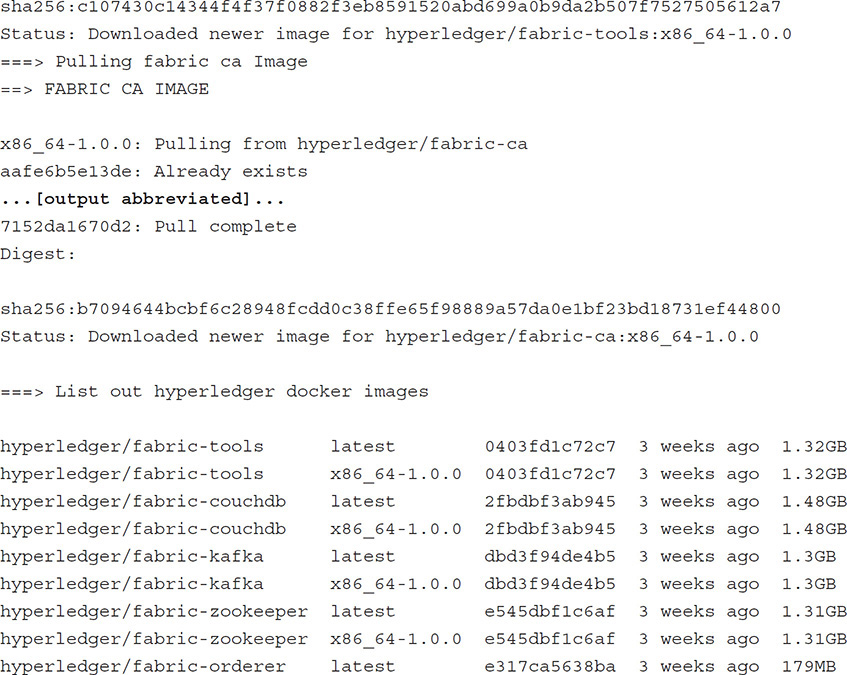

There are four tutorials that come with Hyperledger Fabric. They are:
• write_first_app Designed to show an application developer how to write their first application using the Node.js SDK.
• build_network Oriented toward a network operator going through the process of establishing a blockchain network and deploying a simple application to test it out.
• chaincode4ade Shows a developer how to write business logic agreed to by the members of the network.
• chaincode4noah Demonstrates the administration of business logic by a network operator.
We will now step through the write_first_app tutorial, which again is designed to show the tasks involved and to provide the basis for writing a first application against the Hyperledger Fabric network. As with all other persistence layer–based (i.e., database or file system) applications that you’ve worked on before, this tutorial demonstrates the two common use cases of (1) reading from the chain and (2) writing to (or updating) the chain.
So, the first step is to navigate to the fabric directory and list its contents:

Now start the Fabric network, which does the following:
• Starts a peer node, an ordering node, a Certificate Authority, and a CLI container
• Creates a channel and joins the peer node to the new channel
• Installs a smart contract onto the peer’s file system and instantiates this contract on the channel by starting a chaincode (smart contract) container
• Calls the initLedger function on the smart contract to create 10 cars in the ledger


Now view the processes that have been started:

Now install the SDK node modules so that the sample code will function:
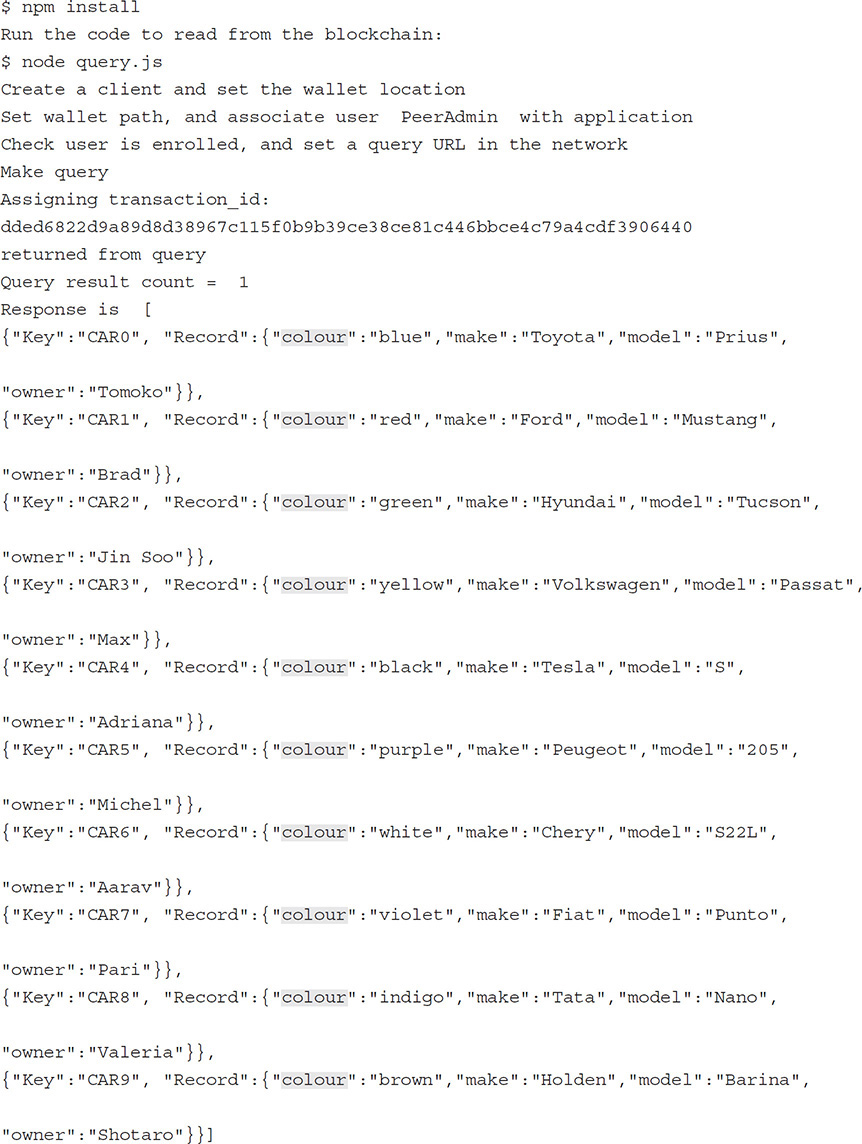
Let’s take a look at the query.js code, in particular the highlighted sections that show how to connect to the chain and then issue a query:


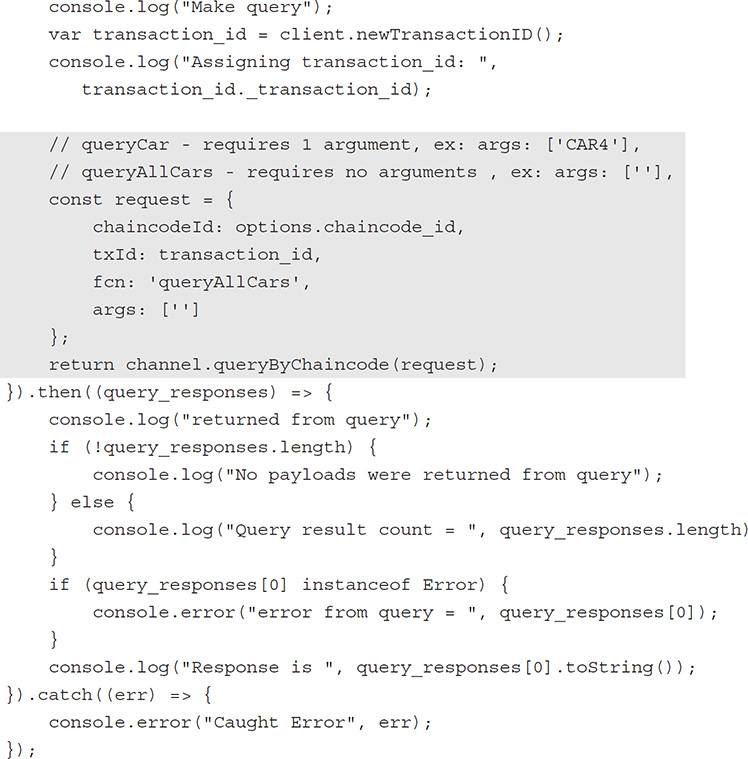
A slight adjustment to the query will let us read by a single key:
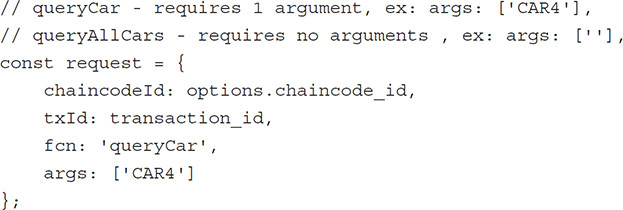
Submitting the adjusted query and showing the response:


Now we can move on to making some changes to the ledger. We will start off with the sample code that will add a new car to the chain. Here is the invoke.js code; again the section for inserting CAR10 is highlighted:




When you execute the insert, here is the response:

After adjusting the query.js code to read the new key (changed ’CAR4’ to ’CAR10’) and executing:


Then execute the invoke.js code:

Run query.js one more time to query CAR10; here is the response:

Now we have stood up the blockchain, read from it, and written to it. The only thing left to do is to shut down the docker instance by issuing the following:


This concludes the Hyperledger Fabric tutorial.
Hyperledger Iroha

Websites:
https://github.com/hyperledger/iroha
https://www.hyperledger.org/projects/iroha
Iroha was contributed to Hyperledger by the Japanese fintech company Soramitsu. It is a business blockchain framework designed to be simple and easy to incorporate into infrastructural projects requiring distributed ledger technology.
Some key features are:
• Creation and management of complex assets, including currencies, rights, serial numbers, patents, etc.
• Management and permission of user accounts (read and write), including business rules for transactions and queries
Iroha’s goal is to provide the following encapsulated C++ components that other projects can use:
• Sumeragi consensus library (inspired by BChain, a chain-style Byzantine replication protocol that propagates transactions among the nodes with a chain topology)
• Ed25519 digital signature library
• SHA-3 hashing library
• Transaction serialization library
• P2P broadcast library
• API server library
• iOS, Android, and JavaScript libraries
• Blockchain explorer/data visualization suite
Hyperledger Sawtooth
![]()
Websites: https://github.com/hyperledger/sawtooth-core
https://www.hyperledger.org/projects/sawtooth
Hyperledger Sawtooth is a modular platform for building, deploying, and running distributed ledgers. Hyperledger Sawtooth includes a proprietary consensus algorithm, Proof of Elapsed Time (PoET), which targets large distributed validator populations with minimal resource consumption.
Hyperledger Tools
All platforms need tools and utilities, and blockchain is no different. The following are the current tools for the Hyperledger platform.
Hyperledger Cello

Websites: https://github.com/hyperledger/cello
https://www.hyperledger.org/projects/cello
Hyperledger Cello is a toolkit that aims to bring the on-demand “as-a-service” deployment model to the blockchain ecosystem. Its goal is to reduce the effort required for the setup, ongoing maintenance, and teardown of blockchains. Its highlights are:
• Instantly provision customizable blockchains, for example, Hyperledger Fabric
• Maintain a pool of executing blockchains on top of baremetals, VMs, Docker Swarm, and Kubernetes
• Administration dashboard that provides system status and allows adjustment to chain numbers or scale resources
Hyperledger Composer

Websites: https://github.com/hyperledger/composer
https://www.hyperledger.org/projects/composer
Hyperledger Composer is a collaboration tool for building blockchain business networks, accelerating the development of smart contracts and their deployment across a distributed ledger. See Figure 8-3 for sample screen captures of the tool. Hyperledger Composer is an extensive, open development collaboration toolset and framework to make developing blockchain applications easier. Its goal is to accelerate producing value by making it easier to model a business network and then integrate a blockchain application with the existing/legacy business systems. It supports existing Hyperledger Fabric blockchains and supports pluggable consensus protocols that have been established by permissioned network members.

FIGURE 8-3 Hyperledger Composer
Hyperledger Explorer

Websites: https://www.hyperledger.org/projects/explorer
https://github.com/hyperledger/blockchain-explorer
Hyperledger Explorer, contributed by IBM, Intel, and DTCC, can view, invoke, deploy, or query blocks, transactions with associated data, network information (e.g., name, status), chain codes and transaction families, and other relevant information contained in the blockchain. See Figure 8-4 for sample screen capture of the tool.

FIGURE 8-4 Hyperledger Explorer
Interbit

Website: http://btl.co/interbit
Interbit is an enterprise-grade blockchain platform that enables applications to be built, managed, and run on a blockchain. Its key features are:
• Privacy Ensures that data is only available to those who have permission to see and change it
• Scalability Provides a platform that can scale to hundreds of thousands of transactions per second
• Portability The first blockchain platform developed that is able to run full nodes on lightweight IoT devices
Monax
![]()
Website: https://monax.io
Monax is a permissionable smart contract machine. Released in December 2014, Monax provides a modular blockchain client with a permissioned smart contract interpreter built in part to the specification of the Ethereum Virtual Machine (EVM). In early 2017, blockchain startup Monax announced they were joining Hyperledger. It is the first code base with an EVM joining the consortium. Swift, an interbank transfer platform, has experimented with the Monax platform as part of its project to look at integrating blockchain into its payments platform. Let’s walk through a Monax tutorial.
Monax Tutorial
One of the first things to be done for this tutorial is to establish the virtual environment; this can be either Docker or Vagrant. We will look at a Vagrant installation. The following assumes that you already have Vagrant installed and you have downloaded the associated monax.box file and the Monax workshop sources.zip file.
The first step is to register the Monax virtual machine:

Then change directory to the workshop material and initialize the vagrant instance:

Then start up the instance:

If you get the above error, it means you haven’t installed VirtualBox. No big deal, just go ahead and download and install it and try starting up the instance again.

The final part of the setup stage for the tutorial is to secure shell into it:

Note that the virtual machine login for the secure shell is contrib-jessie, the login of the person who originally created the virtual instance.
Make a Chain Configuration With the Monax virtual machine setup completed, you can now begin the process of making a chain configuration. This process creates all of the necessary files for a private blockchain within the Monax platform. The following is the help text for the chain’s make command:



In the following command, we make a chain configuration with one full node and three participants:
![]()
Start the workshop chain:
![]()
Copy the user keys and import them into the development keys server:

Note that the import step may take a few minutes.
Tutorial: Phases The next steps are the main deployment and test phases. It begins with Phase 1, which is a job that does the following:
• Deploys the course registry (a Solidity smart contract)
• Registers a participant
• Gets the number of participants registered
• Verifies that the number of course participants is 1
Here are the above steps expressed in the epm.yaml file:


To execute the above work and view the output for Phase 1:

The following listing shows the contents of the Course Registry smart contract being deployed (CourseRegistry.sol file):


The next step in the tutorial, Phase 2, is to run a job that does the following:
• Deploys the course manager (another Solidity smart contract)
• Gets a handle on the course manager
• Registers a participant
• Gets the number of participants registered
• Verifies that the number of course participants is 1
Here are the above steps expressed in the epm.yaml file:


To execute the above work and view the output:

The following listing shows the contents of the course manager smart contract being deployed (CourseManager.sol file):

The following listing shows the contents of the course registry smart contract being deployed (CourseRegistry.sol file):

The following listing shows the contents of the default course registry smart contract being deployed (DefaultCourseRegistry.sol file):


Phase 3 is to run a job that does the following:
• Deploys the course manager (Solidity smart contract)
• Gets a handle on the course manager
• Registers a participant (that fails)
• Gets the number of participants registered
• Verifies that the number of course participants is 0
• Registers a participant (that succeeds)
• Gets the number of participants registered
• Verifies that the number of course participants is 1
Here are the above steps expressed in the epm.yaml file:


To execute the above work and view the output:

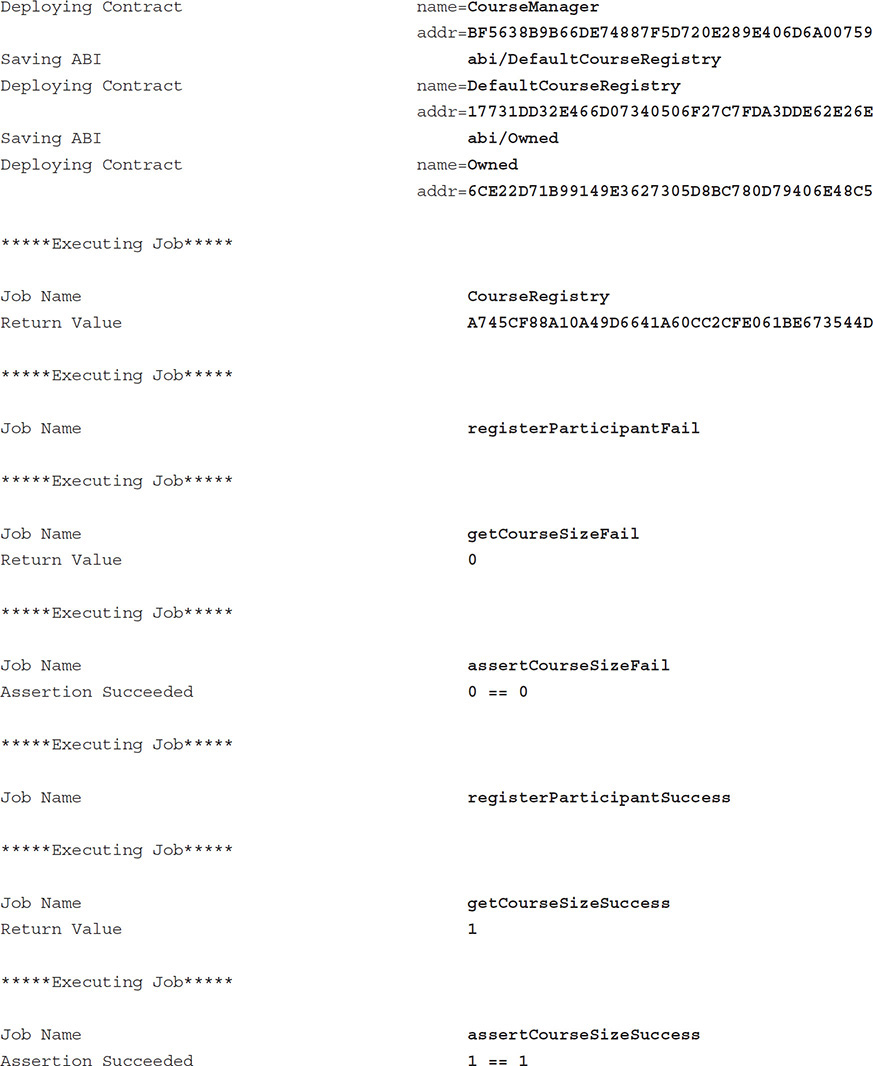
Phase 4 is a job that does the following:
• Deploys the courses library (Solidity smart contract)
• Deploys the course manager (link to the course library)
• Gets a handle on the course manager
• Adds a course (Solidity 101)
• Gets the number of courses available
• Verifies that the number of courses available is 1
• Registers a participant for the available course (Solidity 101)
• Gets the number of participants registered
• Verifies that the number of course participants is 1
Here are the above steps expressed in the epm.yaml file:
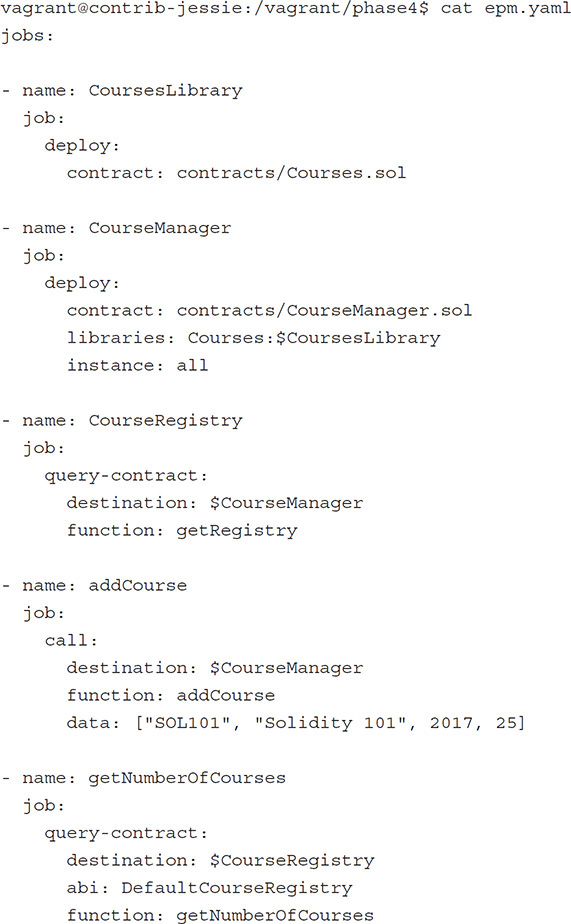

To execute the above work and view the output:


That is the end of the tutorial. Now comes the teardown, which isn’t documented. In order to tear down the whole virtual environment, you will first exit the secure shell, if you haven’t already done so:

Then you can start the teardown process as follows:

The above tutorial is a brief introduction to the Monax offering. It demonstrated defining and starting up a chain, deploying smart contracts written in Solidity, and then calling functions on the smart contracts.
MultiChain

Websites:
https://github.com/MultiChain/multichain
MultiChain is an open-source platform for private chains based on Bitcoin’s blockchain. Its key features are:
• Managed permissions Control over who can connect; send and receive transactions; create assets, streams, and blocks
• Rapid deployment Two steps to create a new blockchain and three to connect to an existing one
• Unlimited assets Tracked and verified at the network level
• Data streams Allow the creation of multiple key-value, time series, or identity databases on a blockchain
MultiChain provides maximal compatibility with the Bitcoin ecosystem, which includes the Bitcoin Core APIs/runtime parameters, the peer-to-peer protocol, and its transaction/block formats.
Openchain
![]()
Websites:
Openchain is an open-source distributed ledger platform for issuing and managing digital assets. The administrator of an Openchain instance defines the rules of the ledger, then the permissioned end users can exchange value on the ledger according to its rules. Each transaction on the ledger is digitally signed.
Openchain is a generic register of asset ownership. Some example use cases are:
• Securities, commodities, currencies
• Ownership titles (land, real estate, music or software licensing)
• Reward, gift, and loyalty cards
Quorum

Websites: https://github.com/jpmorganchase/quorum
https://www.jpmorgan.com/country/US/EN/Quorum
Quorum an open-source distributed ledger platform based on the official Go implementation of Ethereum. It is designed to support applications that require identity and (high-speed/throughput) performance of private transactions within a permissioned group of known participants. One of the design goals of Quorum is to reuse as much existing Ethereum technology as possible and to keep in sync with future versions of the public Ethereum code base.
Quorum also comes with Cakeshop, which is a graphical user interface for working with Quorum networks, smart contracts, and APIs. The Quorum consensus mechanism is based on majority voting, which results in faster blocktimes, transaction finality, and on-demand block creation.
Quorum uses cryptography to shield data from those who are not a party to the transaction. Quorum is a single shared blockchain and a combination of changes to Ethereum along with smart contracts to segment the private data. The Go-Ethereum code base changes are to the block proposal and block validation processes. For block validation, all nodes validate public transactions, and they also validate private transactions that they are party to when executing the contract code associated with the transactions.
Stellar

Website: https://www.stellar.org
Stellar is an open-source, distributed payments infrastructure that connects banks, payment
systems, and people. It enables the building of mobile wallets, banking tools, and smart devices. The servers in the chain communicate and sync with each other to ensure that transactions are valid and get applied to the ledger. Stellar uses its own form of consensus called Stellar Consensus Protocol (SCP). Its key properties are:
• Low latency.
• Digital signatures and hash families.
• Decentralized control where anyone is able to participate and no central authority dictates whose approval is required for consensus.
• Flexible trust. Users have the freedom to trust any combination of parties they see fit. For example, a small nonprofit may play a key role in keeping much larger institutions honest.
Symbiont Assembly

Website: https://symbiont.io/technology/introducing-symbiont-assembly
Symbiont Assembly is an immutable (or “append-only”) database that provides a single, global ledger whose transaction history is replicated out to all nodes in the network. It is a permissioned ledger, where each user signs their transactions so that their identity can be verified by all participants on the network.
Symbiont Assembly uses a proprietary Byzantine fault-tolerant consensus protocol called BFT-SMaRt, which was designed with simplicity and modularity in mind, and has improved performance over public blockchain consensus protocols.
Summary
There are many options for permissioned private blockchains, and the list is likely to grow. In many cases, government/industry regulation dictates that private control is needed. That being said, the freedom, neutrality, and openness that started Bitcoin on the public blockchain are things to keep in mind. The focus of decentralizing control and consensus on the public platform is clearly something to think about. There is a great deal of chatter and concern around privacy, identity, speed, and cost of the public blockchain solutions. It is important to note that by creating privately administered smart contracts on public blockchains, or cross-chain exchange layers that sit in between public and private blockchains, it is possible to deliver some degree of the properties of private blockchains on the public platforms. Time will tell if these types of capabilities and properties ever get built into the public blockchain.
